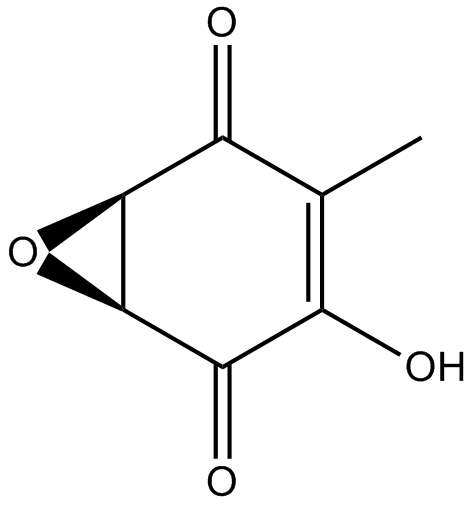(-)-Terreic acid (Synonyms: TA, (-)-Terreic Acid) |
| Catalog No.GC12164 |
Bruton's tyrosine kinase (BTK) inhibitor
Products are for research use only. Not for human use. We do not sell to patients.

Cas No.: 121-40-4
Sample solution is provided at 25 µL, 10mM.
IC50: about 100 μM for binding of GST-BtkPH to PKC, about 30 μM for association of Btk with PKCbII, about 10 μM for JNK1 activity, and about 7 μM for TNF-a and about 3 μM for IL-2.
Terreic acid (TA), which was known as Aspergillus sp. No. Y-8980, was isolated from a soil sample abtained at Yoron Island of Kagoshima Prefecture.
Terreic acid is a quinone epoxide with antibiotic activity. At a mechanism view for its antibiotic action, it inhibits protein synthesis by blocking the formation of leucyl-tRNA in sensitive bacteria [1]. TA was also an inhibitor of Bruton’s tyrosine kinase (Btk) that blocks the PKC-Btk PH domain interaction. Btk plays core roles in mast cell activation and in B cell development [2].
In vitro: Terreic acid showed MIC (minimal inhibitory concentration) of 25 approximately 100 mcg/ml, 50 mcg/ml and 12.5 mcg/ml against Gram-positive and Gram-negative bacteria, Xanthomonas citri and Xanthomonas oryzae and, respectively. TA also showed anti-tumor effect in the concentrations of > 6.25 mcg/ml on human carcinoma cells (HeLa cells) [1]. In lysates of HMC-1 human mast cells, TA can inhibit the binding of GST-BtkPH to PKC with an IC50 of ~100 uM. In mouse mast cells, TA can inhibit the association of Btk with PKCbII at IC50 of ~ 30 uM. JNK1 activity can be inhibited by TA with an IC50 of ~10 uM. Cytokine secretion was severely impaired by TA with an IC50 of ~7 uM for TNF-a and ~ 3 uM for IL-2) [2].
In vivo: In mice, the LD50 (median lethal dose) of TA was 75 mg/kg through i.p. and i.v. TA showed the enough survival effect in dd mice which have been implanted with Ehrlich ascites carcinoma cells, and the effect also was confirmed by anatomies of mice [1].
Clinical trial: So far, no clinical study has been conducted.
References:
[1] Yamamoto H, Moriyama K, Jinnouchi H, Yagishita K. Studies on terreic acid. Jpn J Antibiot. 1980 Mar;33(3):320-8.
[2] Kawakami Y, Hartman SE, Kinoshita E, Suzuki H, Kitaura J, Yao L, Inagaki N, Franco A, Hata D, Maeda-Yamamoto M, Fukamachi H, Nagai H, Kawakami T. Terreic acid, a quinone epoxide inhibitor of Bruton's tyrosine kinase. Proc Natl Acad Sci U S A. 1999 Mar 2;96(5):2227-32.
Average Rating: 5 (Based on Reviews and 37 reference(s) in Google Scholar.)
GLPBIO products are for RESEARCH USE ONLY. Please make sure your review or question is research based.
Required fields are marked with *




















